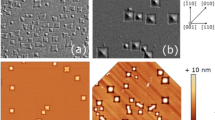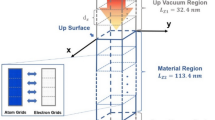Abstract
The threshold laser fluence for the onset of surface melting is calculated for Ni films of different thicknesses and for a bulk Ni target using a combined atomistic-continuum computational model. The model combines the classical molecular dynamics (MD) method for simulation of non-equilibrium processes of lattice superheating and fast phase transformations with a continuum description of the laser excitation and subsequent relaxation of the conduction band electrons based on the two-temperature model (TTM). In the hybrid TTM-MD method, MD substitutes the TTM equation for the lattice temperature, and the diffusion equation for the electron temperature is solved simultaneously with MD integration of the equations of motion of atoms. The dependence of the threshold fluence on the film thickness predicted in TTM-MD simulations qualitatively agrees with TTM calculations, while the values of the thresholds for thick films and bulk targets are ∼10% higher in TTM-MD. The quantitative differences between the predictions of TTM and TTM-MD demonstrate that the kinetics of laser melting as well as the energy partitioning between the thermal energy of atomic vibrations and energy of the collective atomic motion driven by the relaxation of the laser-induced pressure should be taken into account in interpretation of experimental results on surface melting.
Similar content being viewed by others
References
S.-S. Wellershoff, J. Hohlfeld, J. Güdde, E. Matthias: Appl. Phys. A 69, S99 (1999)
M.B. Agranat, S.I. Ashitkov, V.E. Fortov, A.V. Kirillin, A.V. Kostanovskii, S.I. Anisimov, P.S. Kondratenko: Appl. Phys. A 69, 637 (1999)
B. Lin, H.E. Elsayed–Ali: Surf. Sci. 498, 275 (2002)
K. Sokolowski-Tinten, C. Blome, J. Blums, A. Cavalleri, C. Dietrich, A. Tarasevich, I. Uschmann, E. Förster, M. Kammler, M. Horn-von-Hoegen, D. von der Linde: Nature 422, 287 (2003)
B.J. Siwick, J.R. Dwyer, R.E. Jordan, R.J.D. Miller: Science 302, 1382 (2003)
O.P. Uteza, E.G. Gamaly, A.V. Rode, M. Samoc, B. Luther-Davies: in preparation.
S. Preuss, A. Demchuk, M. Stuke: Appl. Phys. A 61, 33 (1995)
T.D. Bennett, C.P. Grigoropoulos, D.J. Krajnovich: J. Appl. Phys. 77, 849 (1995)
M. Hashida, A.F. Semerok, O. Gobert, G. Petite, Y. Izawa, J.F. Wagner: Appl. Surf. Sci. 197–198, 862 (2002)
S.I. Anisimov, B.L. Kapeliovich, T.L. Perel’man: Sov. Phys. JETP 39, 375 (1974)
D.S. Ivanov, L.V. Zhigilei: Phys. Rev. Lett. 91, 105701 (2003)
D.S. Ivanov, L.V. Zhigilei: Phys. Rev. B 68, 064114 (2003)
E. Leveugle, D.S. Ivanov, L.V. Zhigilei: Appl. Phys. A, in press
C. Schäfer, H.M. Urbassek, L.V. Zhigilei: Phys. Rev. B 66, 115404 (2002)
D.S. Ivanov, L.V. Zhigilei, E.M. Bringa, M. De Koning, B.A. Remington, M.J. Caturla, S.M. Pollaine: Proceedings of APS Topical Con-ference on Shock Compression of Condensed Matter, in press (2003)
L.V. Zhigilei, B.J. Garrison: Mat. Res. Soc. Symp. Proc. 538, 491 (1999)
X.W. Zhou, H.N.G. Wadley, R.A. Johnson, D.J. Larson, N. Tabat, A. Cerezo, A.K. Petford-Long, G.D.W. Smith, P.H. Clifton, R.L. Martens, T.F. Kelly: Acta Mater. 49, 4005 (2001)
CRC Handbook of Chemistry and Physics, 72nd edition, ed. by D.R. Lide, (CRC Press, Boca Raton, FL 1991)
Due to a minor difference in the definition of the diffusive penetration depth of excited electrons used in this work and in [1, 21], the value of Lc is larger by a factor of 25/8 as compared to the one reported in [1]. A more significant quantitative discrepancy is observed between the results of TTM calculations reported in [1] and the results presented in Fig. 1b of this paper. In particular, the saturation fluences at which the melting temperature is reached at the surface of thick Ni samples is 220 J/m2 in [1] (Fig. 8b) and 363 J/m2 in our calculations (Fig. 1b). This discrepancy is due to a mistake in the TTM code used in [1], as identified through private communication with one of the authors of [1], Dr. J. Güdde . New test calculations performed by Dr. Güdde and Dr. Rethfeld agree with the data presented in this paper.
B. Rethfeld, K. Sokolowski-Tinten, D. von der Linde, S.I. Anisimov: Phys. Rev. B 65, 092103 (2002)
P.B. Corkum, F. Brunel, N.K. Sherman, T. Srinivasan-Rao: Phys. Rev. Lett. 61, 2886 (1988)
Author information
Authors and Affiliations
Corresponding author
Additional information
PACS
61.80.Az; 64.70.Dv; 02.70.Ns
Rights and permissions
About this article
Cite this article
Ivanov, D., Zhigilei, L. Combined atomistic-continuum model for simulation of laser interaction with metals: application in the calculation of melting thresholds in Ni targets of varying thickness. Appl. Phys. A 79, 977–981 (2004). https://doi.org/10.1007/s00339-004-2607-0
Received:
Accepted:
Published:
Issue Date:
DOI: https://doi.org/10.1007/s00339-004-2607-0




